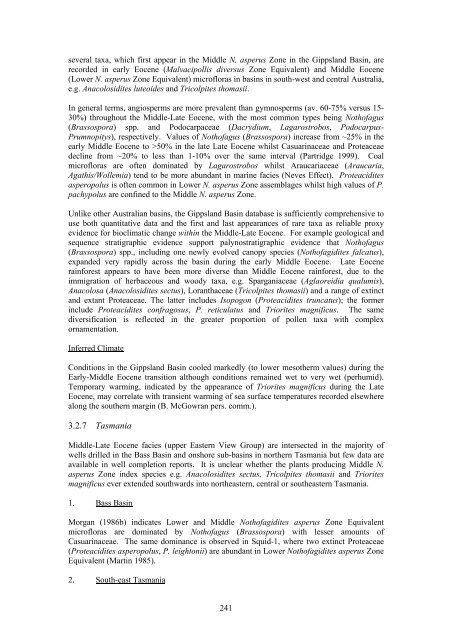OFR 151.pdf - CRC LEME
OFR 151.pdf - CRC LEME
OFR 151.pdf - CRC LEME
You also want an ePaper? Increase the reach of your titles
YUMPU automatically turns print PDFs into web optimized ePapers that Google loves.
several taxa, which first appear in the Middle N. asperus Zone in the Gippsland Basin, are<br />
recorded in early Eocene (Malvacipollis diversus Zone Equivalent) and Middle Eocene<br />
(Lower N. asperus Zone Equivalent) microfloras in basins in south-west and central Australia,<br />
e.g. Anacolosidites luteoides and Tricolpites thomasii.<br />
In general terms, angiosperms are more prevalent than gymnosperms (av. 60-75% versus 15-<br />
30%) throughout the Middle-Late Eocene, with the most common types being Nothofagus<br />
(Brassospora) spp. and Podocarpaceae (Dacrydium, Lagarostrobos, Podocarpus-<br />
Prumnopitys), respectively. Values of Nothofagus (Brassospora) increase from ~25% in the<br />
early Middle Eocene to >50% in the late Late Eocene whilst Casuarinaceae and Proteaceae<br />
decline from ~20% to less than 1-10% over the same interval (Partridge 1999). Coal<br />
microfloras are often dominated by Lagarostrobos whilst Araucariaceae (Araucaria,<br />
Agathis/Wollemia) tend to be more abundant in marine facies (Neves Effect). Proteacidites<br />
asperopolus is often common in Lower N. asperus Zone assemblages whilst high values of P.<br />
pachypolus are confined to the Middle N. asperus Zone.<br />
Unlike other Australian basins, the Gippsland Basin database is sufficiently comprehensive to<br />
use both quantitative data and the first and last appearances of rare taxa as reliable proxy<br />
evidence for bioclimatic change within the Middle-Late Eocene. For example geological and<br />
sequence stratigraphic evidence support palynostratigraphic evidence that Nothofagus<br />
(Brassospora) spp., including one newly evolved canopy species (Nothofagidites falcatus),<br />
expanded very rapidly across the basin during the early Middle Eocene. Late Eocene<br />
rainforest appears to have been more diverse than Middle Eocene rainforest, due to the<br />
immigration of herbaceous and woody taxa, e.g. Sparganiaceae (Aglaoreidia qualumis),<br />
Anacolosa (Anacolosidites sectus), Loranthaceae (Tricolpites thomasii) and a range of extinct<br />
and extant Proteaceae. The latter includes Isopogon (Proteacidites truncatus); the former<br />
include Proteacidites confragosus, P. reticulatus and Triorites magnificus. The same<br />
diversification is reflected in the greater proportion of pollen taxa with complex<br />
ornamentation.<br />
Inferred Climate<br />
Conditions in the Gippsland Basin cooled markedly (to lower mesotherm values) during the<br />
Early-Middle Eocene transition although conditions remained wet to very wet (perhumid).<br />
Temporary warming, indicated by the appearance of Triorites magnificus during the Late<br />
Eocene, may correlate with transient warming of sea surface temperatures recorded elsewhere<br />
along the southern margin (B. McGowran pers. comm.).<br />
3.2.7 Tasmania<br />
Middle-Late Eocene facies (upper Eastern View Group) are intersected in the majority of<br />
wells drilled in the Bass Basin and onshore sub-basins in northern Tasmania but few data are<br />
available in well completion reports. It is unclear whether the plants producing Middle N.<br />
asperus Zone index species e.g. Anacolosidites sectus, Tricolpites thomasii and Triorites<br />
magnificus ever extended southwards into northeastern, central or southeastern Tasmania.<br />
1. Bass Basin<br />
Morgan (1986b) indicates Lower and Middle Nothofagidites asperus Zone Equivalent<br />
microfloras are dominated by Nothofagus (Brassospora) with lesser amounts of<br />
Casuarinaceae. The same dominance is observed in Squid-1, where two extinct Proteaceae<br />
(Proteacidites asperopolus, P. leightonii) are abundant in Lower Nothofagidites asperus Zone<br />
Equivalent (Martin 1985).<br />
2. South-east Tasmania<br />
241

















